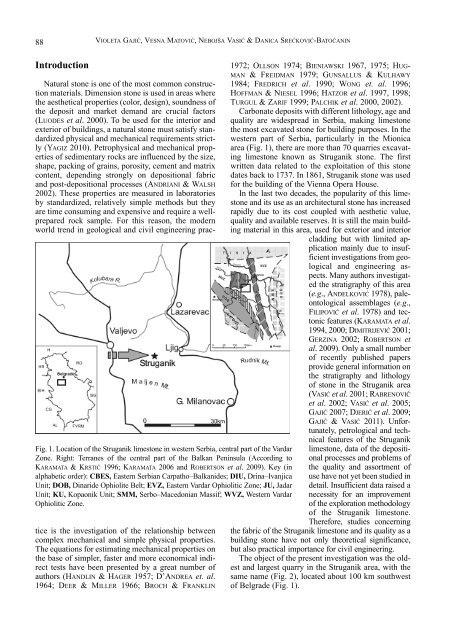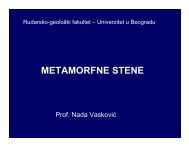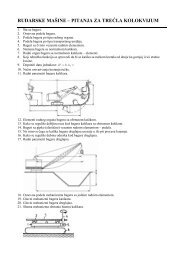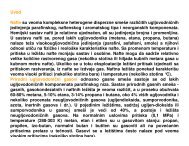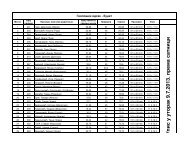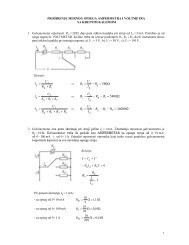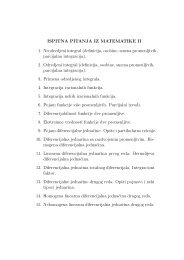KÑига LXXII
KÑига LXXII
KÑига LXXII
You also want an ePaper? Increase the reach of your titles
YUMPU automatically turns print PDFs into web optimized ePapers that Google loves.
88<br />
VIOLETA GAJIĆ, VESNA MATOVIĆ, NEBOJŠA VASIĆ & DANICA SREĆKOVIĆ-BATOĆANIN<br />
Introduction<br />
Fig. 1. Location of the Struganik limestone in western Serbia, central part of the Vardar<br />
Zone. Right: Terranes of the central part of the Balkan Peninsula (According to<br />
KARAMATA & KRSTIĆ 1996; KARAMATA 2006 and ROBERTSON et al. 2009). Key (in<br />
alphabetic order): CBES, Eastern Serbian Carpatho–Balkanides; DIU, Drina–Ivanjica<br />
Unit; DOB, Dinaride Ophiolite Belt; EVZ, Eastern Vardar Ophiolitic Zone; JU, Jadar<br />
Unit; KU, Kopaonik Unit; SMM, Serbo–Macedonian Massif; WVZ, Western Vardar<br />
Ophiolitic Zone.<br />
Natural stone is one of the most common construction<br />
materials. Dimension stone is used in areas where<br />
the aesthetical properties (color, design), soundness of<br />
the deposit and market demand are crucial factors<br />
(LUODES et al. 2000). To be used for the interior and<br />
exterior of buildings, a natural stone must satisfy standardized<br />
physical and mechanical requirements strictly<br />
(YAGIZ 2010). Petrophysical and mechanical properties<br />
of sedimentary rocks are influenced by the size,<br />
shape, packing of grains, porosity, cement and matrix<br />
content, depending strongly on depositional fabric<br />
and post-depositional processes (ANDRIANI & WALSH<br />
2002). These properties are measured in laboratories<br />
by standardized, relatively simple methods but they<br />
are time consuming and expensive and require a wellprepared<br />
rock sample. For this reason, the modern<br />
world trend in geological and civil engineering practice<br />
is the investigation of the relationship between<br />
complex mechanical and simple physical properties.<br />
The equations for estimating mechanical properties on<br />
the base of simpler, faster and more economical indirect<br />
tests have been presented by a great number of<br />
authors (HANDLIN & HAGER 1957; D’ANDREA et. al.<br />
1964; DEER & MILLER 1966; BROCH & FRANKLIN<br />
1972; OLLSON 1974; BIENIAWSKI 1967, 1975; HUG-<br />
MAN & FREIDMAN 1979; GUNSALLUS & KULHAWY<br />
1984; FREDRICH et al. 1990; WONG et. al. 1996;<br />
HOFFMAN & NIESEL 1996; HATZOR et al. 1997, 1998;<br />
TURGUL & ZARIF 1999; PALCHIK et al. 2000, 2002).<br />
Carbonate deposits with different lithology, age and<br />
quality are widespread in Serbia, making limestone<br />
the most excavated stone for building purposes. In the<br />
western part of Serbia, particularly in the Mionica<br />
area (Fig. 1), there are more than 70 quarries excavating<br />
limestone known as Struganik stone. The first<br />
written data related to the exploitation of this stone<br />
dates back to 1737. In 1861, Struganik stone was used<br />
for the building of the Vienna Opera House.<br />
In the last two decades, the popularity of this limestone<br />
and its use as an architectural stone has increased<br />
rapidly due to its cost coupled with aesthetic value,<br />
quality and available reserves. It is still the main building<br />
material in this area, used for exterior and interior<br />
cladding but with limited application<br />
mainly due to insufficient<br />
investigations from geological<br />
and engineering aspects.<br />
Many authors investigated<br />
the stratigraphy of this area<br />
(e.g., ANĐELKOVIĆ 1978), paleontological<br />
assemblages (e.g.,<br />
FILIPOVIĆ et al. 1978) and tectonic<br />
features (KARAMATA et al.<br />
1994, 2000; DIMITRIJEVIĆ 2001;<br />
GERZINA 2002; ROBERTSON et<br />
al. 2009). Only a small number<br />
of recently published papers<br />
provide general information on<br />
the stratigraphy and lithology<br />
of stone in the Struganik area<br />
(VASIĆ et al. 2001; RABRENOVIĆ<br />
et al. 2002; VASIĆ et al. 2005;<br />
GAJIĆ 2007; DJERIĆ et al. 2009;<br />
GAJIĆ & VASIĆ 2011). Unfortunately,<br />
petrological and technical<br />
features of the Struganik<br />
limestone, data of the depositional<br />
processes and problems of<br />
the quality and assortment of<br />
use have not yet been studied in<br />
detail. Insufficient data raised a<br />
necessity for an improvement<br />
of the exploration methodology<br />
of the Struganik limestone.<br />
Therefore, studies concerning<br />
the fabric of the Struganik limestone and its quality as a<br />
building stone have not only theoretical significance,<br />
but also practical importance for civil engineering.<br />
The object of the present investigation was the oldest<br />
and largest quarry in the Struganik area, with the<br />
same name (Fig. 2), located about 100 km southwest<br />
of Belgrade (Fig. 1).


